
Título
Simulation of Cold Forging Processes Using a Mixed Isotropic-Kinematik Hardening ModelVersión
Postprint
Derechos
© 2021 The Minerals, Metals & Materials SocietyAcceso
Acceso abiertoVersión del editor
https://doi.org/10.1007/978-3-030-75381-8_64Publicado en
Forming the Future. The Minerals, Metals & Materials Series Daehn G., Cao J., Kinsey B., Tekkaya E., Vivek A., Yoshida Y. (eds). Pp. 773-787. Springer, 2021Editor
SpringerPalabras clave
Cold forgingNumerical simulation
Mixed hardening law
Resumen
Cold forging is a manufacturing process where a bar stock is inserted into a die and squeezed with a second closed die. It is one of the most widely used chipless forming processes, often requiring no ... [+]
Cold forging is a manufacturing process where a bar stock is inserted into a die and squeezed with a second closed die. It is one of the most widely used chipless forming processes, often requiring no machining or additional operations to get tight tolerances. Because materials to be formed are increasingly harder and the geometrical complexity is greater, the finite element simulation is becoming an essential tool for process design. This study proposes the use of the Chaboche hardening model for the cold forging simulation of a 42CrMoS4Al material industrial automotive ball pin. The material model has been fitted with experimental data obtained from cyclic torsion tests at different reversal plastic strains as well as monotonic torsion tests at different strain rates. Comparison between the classical isotropic hardening and the new mixed hardening model are presented for the different forging steps. [-]
Sponsorship
Gobierno Vasco-Eusko JaurlaritzaID Proyecto
info:eu-repo/grantAgreement/GV/Elkartek 2018/KK-2018-00025/CAPV/Desarrollo de distintos métodos de alivio de tensiones residuales en chapas metálicas (2ª parte)/RELASHEETColecciones
- Congresos - Ingeniería [425]




















